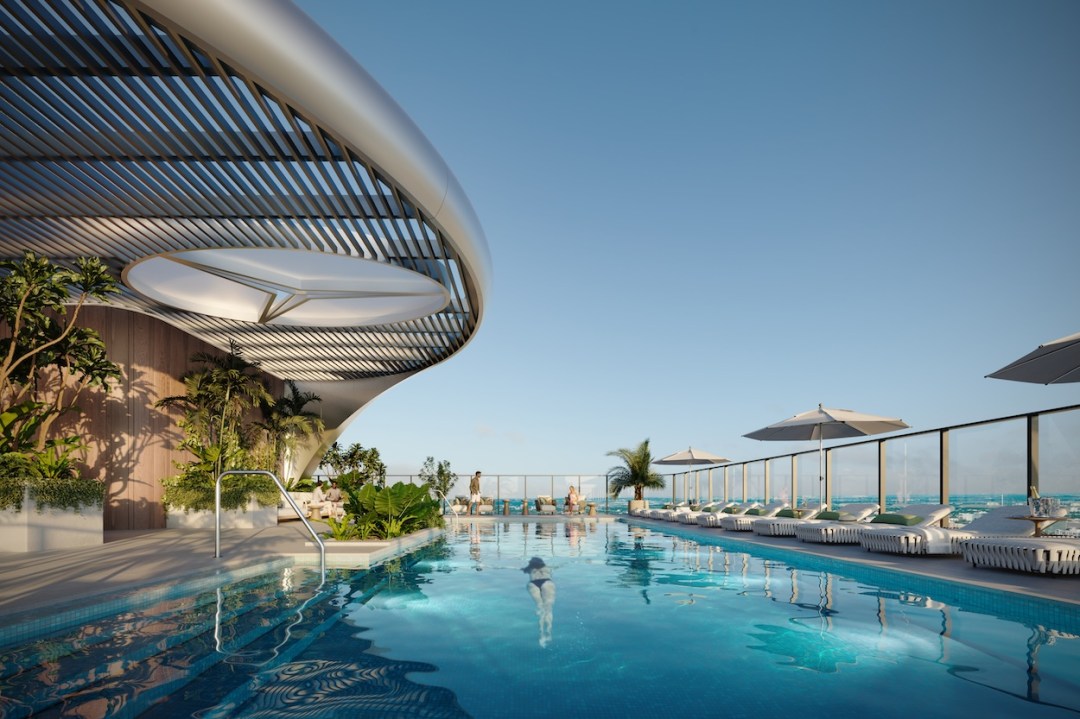As an 11-year-old, I tried to persuade my mother that we should sell our Victorian farmhouse in the Wiltshire countryside and pour every penny into a brand-new 212mph Jaguar XJ220, which cost £435,000 at the time. We would simply live inside this low-slung two-seat supercar, parked up in a lay-by with a washing line hung between the car aerial and a nearby tree.
‘We’re not just doing that to be cool, we’re doing it because it makes us more money’
Now an alternative has arisen. Car manufacturers are racing to build luxury residential towers in the enclaves of flashy money. In Miami and Dubai, Mercedes-Benz is putting the three-pointed star on buildings designed to accommodate their aspirant demographic. Developer JDS is constructing a 67-storey tower in Miami’s financial district that will house 791 residences and a Formula 1 sim-racing room, with interiors designed in collaboration with Mercedes. Right now, it’s a big hole in the ground, but completion is expected in 2027. Prices range from £630,000 for a studio to £2.2 million for a three-bed, topping out at around £4 million for a penthouse.
The prices for the Dubai project are in another league. Mercedes’s 65-storey tower, which began construction in January, will give each private apartment and outdoor pool and unobstructed views of the world’s tallest building, the Burj Khalifa. Prices start at £1.9 million for a two-bed, while its ‘triplex’ 47,000 sq ft ‘Uhlenhaut’ penthouse (named after the 1955 300 SLR Uhlenhaut coupé, of which just two were built and which, at £138 million, holds the record for the highest price ever paid for a car) is on the market for even more than the car its named after: 160 million big ones.
We’re seeing a trend not just among car companies but other luxury brands in putting their names and design expertise to living rooms. Dolce & Gabbana, Cipriani, Armani, Bulgari, Baccarat and Jacob & Co are all involved in building residential towers. The Jacob & Co skyscraper, under construction in Dubai, will be particularly unsightly: it is crowned with an actual crown – a huge summit of coloured glass spikes and bling. Among certain international consumers, these brands represent a purchasable personality, which is convenient if you don’t have any personality of your own.
Developers and luxury brands are flogging cesspits of superficiality by the square-metre. Car culture counts as genuine culture in these nouveau riche ghettos where there’s nothing to do but gorge at Nobu or Cipriani and then pop next door for liposuction. Bored housewives and bitter mistresses while away their afternoons at the beauty salon, which leaves their benefactors driving aimlessly around in their million-dollar supercars gagging for attention.
Mercedes’ actual car designers have been involved in their respective projects, and if you’re the sort of person who feels particularly at home in the back of an S-Class, you’ll likely approve of the fixtures and fittings – lots of obsidian, walnut accents and chrome details. The kitchens’ integrated appliances and cabinetry are made to look like a car dashboards. Yet the exterior of the Miami building, which looks vaguely like six car batteries stacked atop one another, had been signed off before Mercedes became involved. By contrast, Merc has been entrenched in the Dubai project from the basement up; a phallic skyscraper not unlike London’s Gherkin, but sleeker, capped with an arch, clad in photovoltaic panels and covered in thousands of illuminated Mercedes logos.
It’s been developed by Dubai firm Binghatti, which has also started construction of a Bugatti-branded 43-storey condo (and is responsible for the Jacob & Co eyesore, too). Developer Muhammed Binghatti is a petrolhead. He says he can identify any sports car from a mile away. ‘It’s the same with watches,’ he tells me, a Jacob & Co x Bugatti Chiron tourbillon jutting out from under the cuff of his white dishdasha. ‘I’m trying to do the same with architecture and real estate. We need children to point to our buildings. We want to create super-buildings that evoke emotions in an 11-year-old.’ We’re way beyond Jaguars in lay-bys now.
Dubai is almost ten years behind the Miami curve. The first to arrive on the scene was the Porsche Design Miami Tower on Sunny Isles Beach, completed in 2017. It has robotic elevators that enable the residents to sit behind the wheel of their cars as they ascend the 195-metre tower, and then park directly outside their apartment. Sometimes you have to wonder whether necessity really is the mother of invention. It’s been designed both for the congenitally lazy (when walking to the lift is too much hassle in itself) and those who might not want to be exposed to sunlight – people under threat of assassination, and vampires. Miami seems to attract both.
This patented invention, known as the Dezervator, is the brainchild of another billionaire developer, Donald Trump associate Gil Dezer, who ‘drives’ me 60 storeys up to one of his flats in a Porsche Cayenne. After explaining how the terraces afford privacy if one wishes to engage in outdoor sex, Dezer tells me that an increasing number of multi-millionaires from New York and LA are buying second homes in Miami. ‘And, of course, Miami is the capital of South America. This is where the wealthy Latinos come to enjoy their wealth. They daren’t risk driving a Ferrari or wearing a nice watch south of the border, but they can do it here. Car culture in Miami is huge. They can store their exotic cars here, they can enjoy the Concours Club,’ a private race track next to Miami’s executive airport, which has a £295,000 joining fee. He continued, ‘We decided to make a building for car enthusiasts. We said, let’s build living rooms where you can park your car. Everybody thought, man, you’re fucking crazy. But the “a ha” moment was the car elevator, and we’re not just doing that to be cool, we’re doing it because it makes us more money.’
Among certain international consumers, these brands represent a purchasable personality
Such has been the Porsche Design Tower’s success, Dezer has started building another tower next door for Bentley. It’ll also have Dezervators. And no, you don’t have to drive a Bentley. ‘It’s a broad church,’ jokes Bentley’s head of brand partnerships, James Pillar. ‘They’re buying it for the brand, the aesthetics, the quality on its own merit. So, we welcome all, and we would love to turn more real estate customers into car customers as a result, of course.’ Will there be a dealership on the ground floor in case the urge takes them? ‘The appeal is, it’s not a commercial property. This is a home. It would be inappropriate to have a showroom. This is not “car guys designing car things for car guys”. It’s been designed to look beautiful in its own right.’
In May this year, Aston Martin Residences opened its doors onto the downtown Biscayne Bay waterfront. Sixty-six storeys tall, it has a helipad on the roof and the highest swimming pool in Florida. The triplex penthouse is on the market at £46.5 million (and is rising as prospective tenants gazump one another). It comes with an Aston Martin Vulcan, one of just 24 track-only hypercars, which is currently valued at £2.7 million.
In each case cited, the developer approached the car brand, rather than vice versa. The car company’s investment is their brand and their time. The architects work with the brand’s in-house team to create something where every inch is in tune with the DNA of its automotive cousins. Aston Martin’s chief creative officer Marek Reichman has been especially involved in the Aston Martin Residences project. ‘The developer called me about doing some residences, to which I said “no, sorry, we just do cars. Bye,”’ says Reichman. ‘But they were pretty persistent.’ Everything, Reichman says, is designed with the feeling of an Aston Martin ‘even down to the car ramp angles. If you drive a Porsche or Ferrari up there you’ll have to go a bit slower because the approach angle is different. If you’re an Aston Martin owner, it feels like you fit. And, because of the high value of the residences, it’s perfect for our consumer group.’
More accommodating than the grandest of grand tourers, these branded homes have found a profitable niche high above the highways. The danger though, certainly for those who don’t have a particular ardour for automobiles, is that they’ll find sitting at home feels rather like being stuck in traffic.








Comments